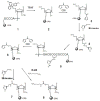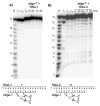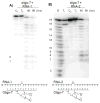Hydrolysis of bulged nucleotides in hybrids formed by RNA and imidazole-derivatized oligo-2'-O-methylribonucleotides
- PMID: 21491332
- PMCID: PMC3097529
- DOI: 10.1080/15257770.2011.569810
Hydrolysis of bulged nucleotides in hybrids formed by RNA and imidazole-derivatized oligo-2'-O-methylribonucleotides
Abstract
In order to enhance the efficacy of small antisense molecules, we examined a series of antisense oligonucleotides derivatized with functional groups designed to enable them to hydrolyze their RNA target. Solid phase synthetic methods were used to prepare imidazole-derivatized antisense oligo-2'-O-methylribonucleotides. Upon binding, these oligonucleotides create internal bulged bases in the target RNA that serve as sites for hydrolysis. We observed that an oligonucleotide derivatized with a side chain containing two imidazole groups was capable of hydrolyzing 58% of its RNA target when incubated with the target for 48 hours at 37°C and physiological pH.
Figures








Similar articles
-
3'-methylphosphonate-modified oligo-2'-O-methylribonucleotides and their Tat peptide conjugates: uptake and stability in mouse fibroblasts in culture.Bioconjug Chem. 2004 May-Jun;15(3):498-507. doi: 10.1021/bc049977+. Bioconjug Chem. 2004. PMID: 15149177
-
[Highly efficient site-directed RNA cleavage by imidazole-containing conjugates of antisense oligonucleotides].Mol Biol (Mosk). 2002 Jul-Aug;36(4):731-9. Mol Biol (Mosk). 2002. PMID: 12173480 Russian.
-
Helix-stabilizing compounds CC-1065 and U-71,184 bind to RNA-DNA and DNA-DNA duplexes containing modified internucleotide linkages and stabilize duplexes against thermal melting.Antisense Res Dev. 1995 Spring;5(1):49-57. doi: 10.1089/ard.1995.5.49. Antisense Res Dev. 1995. PMID: 7542048
-
True antisense oligonucleotides with modified nucleotides restricted in the N-conformation.Curr Top Med Chem. 2007;7(7):661-5. doi: 10.2174/156802607780487768. Curr Top Med Chem. 2007. PMID: 17430207 Review.
-
Antisense oligonucleotides made of 2'-O-alkylRNA: their properties and applications in RNA biochemistry.FEBS Lett. 1993 Jun 28;325(1-2):123-7. doi: 10.1016/0014-5793(93)81427-2. FEBS Lett. 1993. PMID: 7685712 Review.
Cited by
-
Cellular stress induced alterations in microRNA let-7a and let-7b expression are dependent on p53.PLoS One. 2011;6(10):e24429. doi: 10.1371/journal.pone.0024429. Epub 2011 Oct 11. PLoS One. 2011. PMID: 22022355 Free PMC article.
-
Cleavage of pyrene-stabilized RNA bulge loops by trans-(±)-cyclohexane-1,2-diamine.Chem Cent J. 2012 Jan 13;6:3. doi: 10.1186/1752-153X-6-3. Chem Cent J. 2012. PMID: 22244351 Free PMC article.
References
-
- Prakash TP, Bhat B. 2′-Modified oligonucleotides for antisense therapeutics. Curr Top Med Chem. 2007;7(7):641–9. - PubMed
-
- Zamaratski E, Pradeepkumar PI, Chattopadhyaya J. A critical survey of the structure-function of the antisense oligo/RNA heteroduplex as substrate for RNase H. J Biochem Biophys Methods. 2001;48(3):189–208. - PubMed
-
- Fabani MM, Turner JJ, Gait MJ. Oligonucleotide analogs as antiviral agents. Curr Opin Mol Ther. 2006;8(2):108–14. - PubMed
-
- Hogrefe HH, Hogrefe RI, et al. Kinetic analysis of Escherichia coli RNase H using DNA-RNA-DNA/DNA substrates. J Biol Chem. 1990;265(10):5561–6. - PubMed
Publication types
MeSH terms
Substances
Grants and funding
LinkOut - more resources
Full Text Sources
Other Literature Sources
